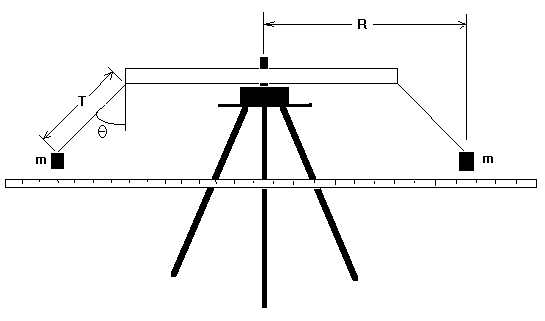
You can click on the image to download it in gif format.

You can click on the image to download it in gif format.
A mass will orbit a some fixed point because it is attached to a string which keeps it in a circular path.
The vertical component of the tension in the string will be given by the force on the mass due to gravity, and the horizontal component will be given by the force required of the string to overcome the inertia of the mass and keep it moving in a circular path. From the radius of rotation and the length of the strings we can derive the inclination of the string. From this, the mass, and the known value of g, we may compute the angular velocity and the tension in the string.
Equipment needed:
With the turntable spinning at about 30 rpm, the masses will swing outward. Sighting downwards, students can determine the change in separation as the difference between the initial separation with the two-meter stick and current radius of rotation.
Given this information and one other known the students can find many different things about the situation. They can determine, from the acceleration of gravity and the centripetal acceleration resulting from tension in the string (mV2/r) the angular velocity of the turntable. Given the turntable they can calculate g and compare to the accepted value.
Given the mass they can find the tension in a string. This can be checked by using pulleys on the ends of the crossbar and attaching the strings to spring force gauges. An allowance must be made for the stretch of the force gauge as to the hanging length of the masses.
(1) To hold the crossbar to the turntable, tape works just fine.
(2) The RPM of the turntable should be discovered before class. It's easy to do just by sitting there and counting 10 rotations with a stopwatch. It should end up at a standard record player speed.
(3) The ropes need to be able to swing for a while so that any odd transient oscillations have time to die out. Tall students (apologies to the vertically challenged) should be picked to observe the position of the masses, and it should be made clear that they are to attempt to observe as close to the center of mass as possible.
(4) Everything that could interfere with the swing of the masses must be adjusted. This could include the stand, the meter stick, the power cord, and any miscellaneous objects nearby like desks.
(5) Tall students should be selected to observe the position of the masses, and it should be made clear that they are to attempt to make observations as close to the center of mass as possible.